There are few products which we wholeheartedly recommend. One of them is a MikroTik CRS305-1G-4S+IN. It is not the fastest switch. It is not from a big name networking vendor. What represents is perhaps the best value in 10GbE networking for a home or small office environment. In our review, we are going to show you why this four-port SFP+ 10GbE switch (plus single 1GbE) is a must-have at only around $125-$149 new. At $500 we could not give the switch the same recommendation, but at this price level, it is a great tool.
MikroTik CRS305-1G-4S+IN Video
We are releasing a video on the MikroTik CRS305-1G-4S+IN as an update to this review.
In this video, Patrick goes into some of the color commentaries about why we replace these low-cost models often. In this article, we have an analysis of why.
MikroTik CRS305-1G-4S+IN Overview
Before we get into the overview, you have probably seen the MikroTik CRS305-1G-4S+IN and perhaps not even known it. Here is an example from Arm TechCon 2019 last week. If you look to the left of the VMware ESXi on Arm demo booth below the Ricola and coffee cup. The silver box covered in wires is a CRS305-1G-4S+IN running a demo with Mellanox Bluefield SmartNICs running VMware on Arm. These switches are small and low power which makes them great whenever you need a small switch but do not have the power/ space for something larger.
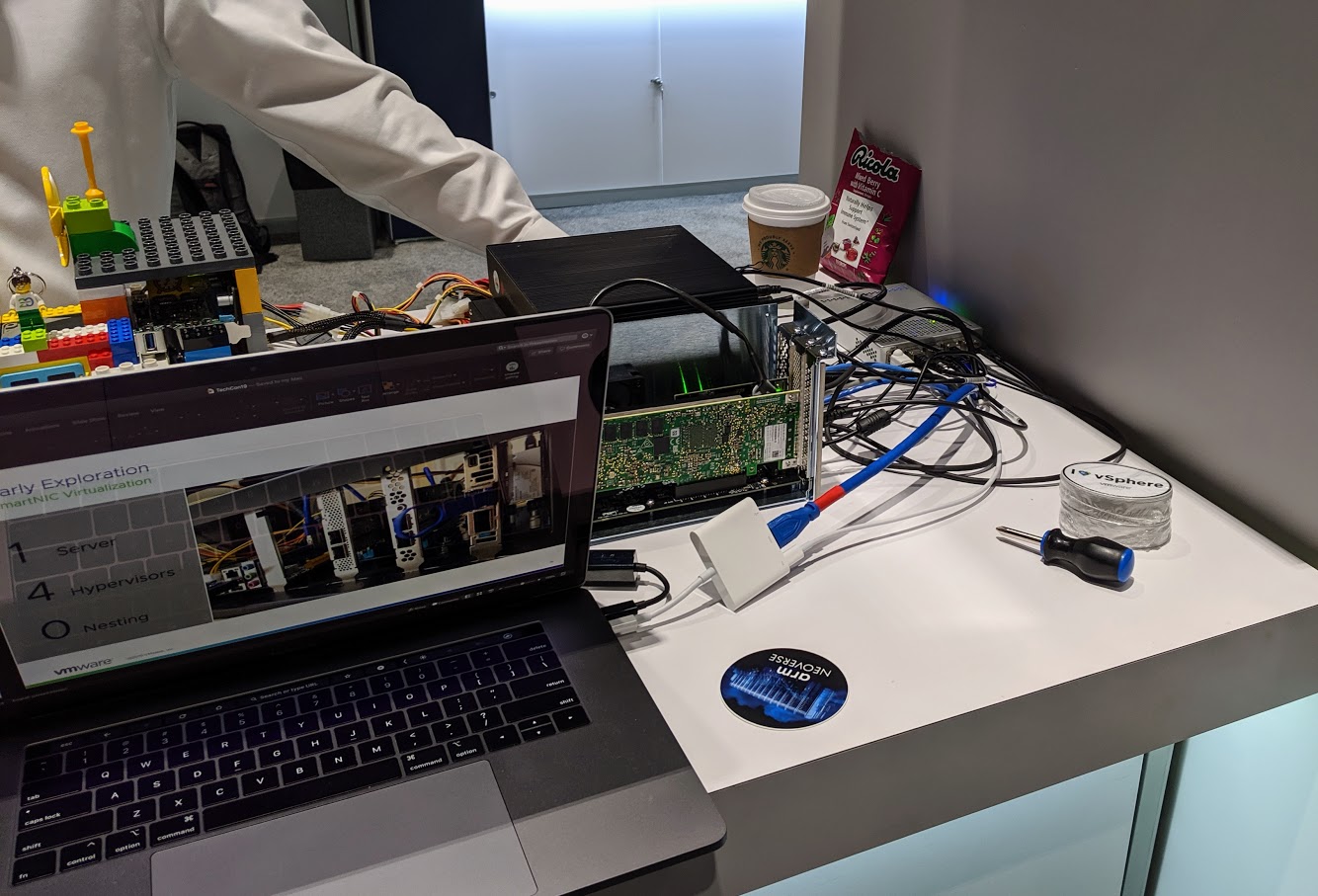
Here is the front, or the “business end” of the MikroTik CRS305-1G-4S+IN. There are five ports in total. The 1GbE port on the left we normally use for 1GbE networking. This generally goes to our management network plus it has a special feature: it is a PoE input. The CRS305-1G-4S+IN is such a low power device that you can power it from a PoE input minimizing the number of cables you need to run to it. More on power soon.
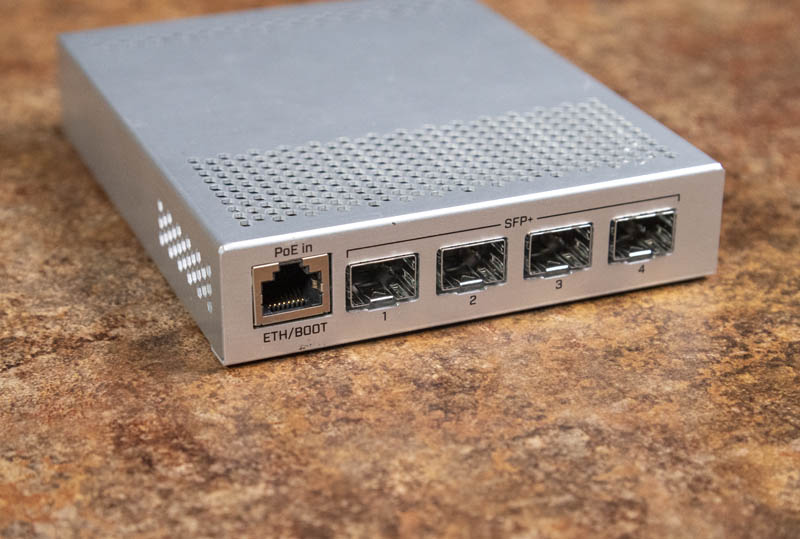
The other four ports are SFP+ ports. In a switch like this, you are most likely going to use either SFP+ optical transceivers or SFP+ DACs. We have used Cisco, Juniper, Arista, Mellanox, and Intel coded optics and DACs without issue. MikroTik, thankfully, does not make this low-cost switch picky on optics. If you want something MikroTik branded, they have very inexpensive options based on what kind of fiber run you are doing.
On the side of the switch, you can see the various LEDs and a reset button. We wish these were next to the SFP+ connections so it is easier to tie ports to LEDs, but at this price point this is an acceptable solution.
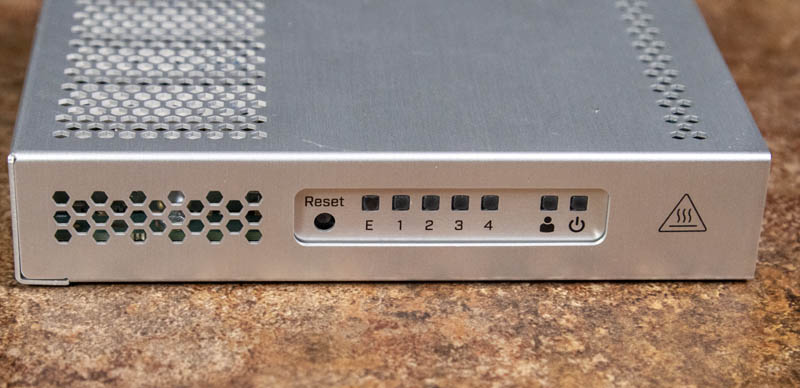
Moving to the rear of the unit, we find what may be one of the most unique features. There are two power inputs. Technically, that means that this switch has three power inputs or one more than our 32-port Dell Z9100-ON 100GbE switch that costs over $10,000. On a device in this price/ performance range, if it had a single DC input or was simply PoE only, it would be everything we expect. In this case, we have one more.
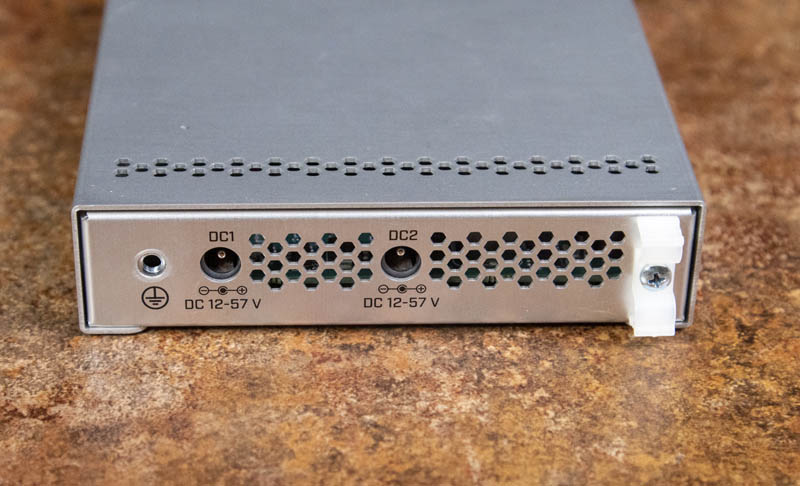
Underneath the unit we have rubber feet installed. There are also mounting points in the event you wanted to put this switch under a desk, in a closet, on a wall or similar.
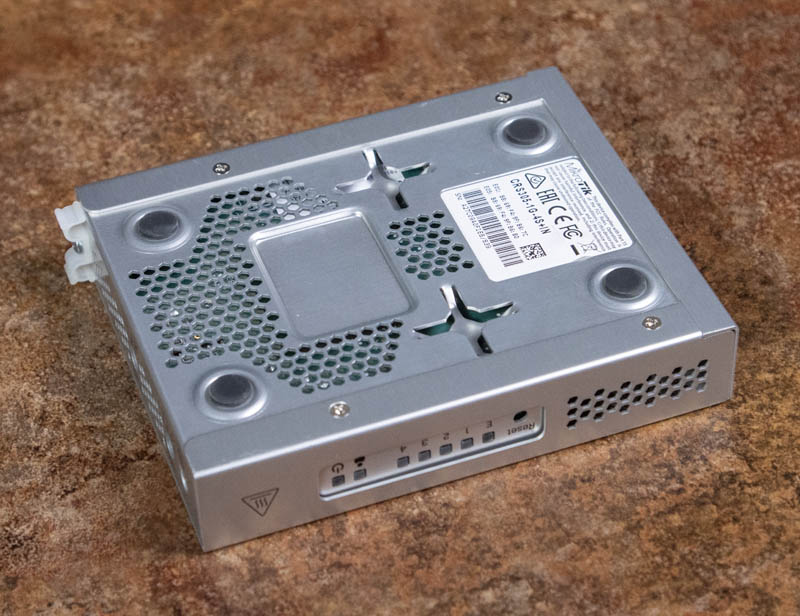
You probably noticed throughout the overview that the case is very porous. Holes are everywhere. This is a passively cooled device. That means there are no fans and it runs silently. It also means that if you do mount this on your workspace, you need to be careful of liquids so they do not pour into the switch. The switch also gets very hot during operation, so ensure you are not going to bump into it. You can see the hot surface warning triangle label. It is small, just keep it away from where you may accidentally swipe it.
The Counterpoint: MikroTik CRS309-1G-8S+IN
There is a very good reason not to get this switch. For only about $110 more, or less than twice as much, you can get a MikroTik CRS309-1G-8S+IN. This is a larger, still passively cooled switch with eight SFP+ ports and a single 1GbE port. Effectively, one gets twice as many ports with that switch than with the MikroTik CRS305-1G-4S+IN.
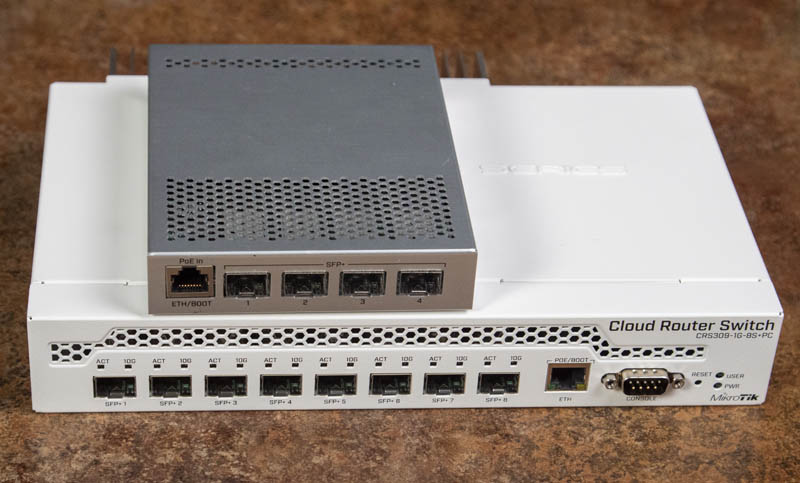
If you recall how we mentioned that in this segment if a switch only has a single DC input that would be our expectation, the CRS309 has only one input. It is not often a lower-end model has redundant power inputs while the higher-cost model does not.
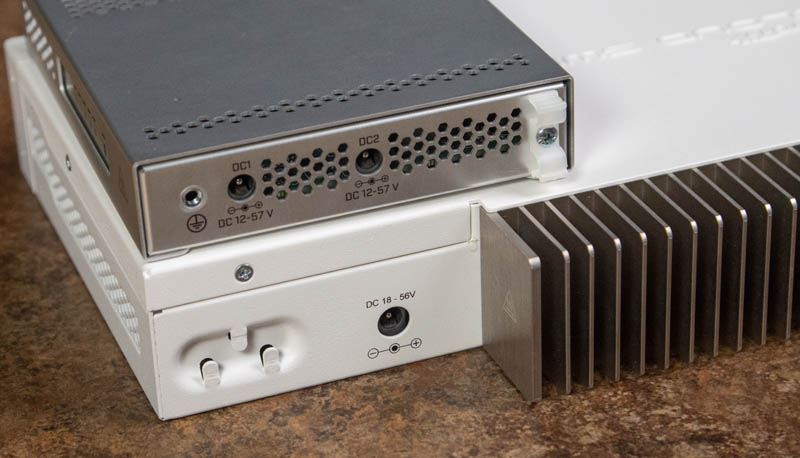
In either case, these are very affordable options. The MikroTik CRS309-1G-8S+IN is the better switch if you need more SFP+ ports. On the other hand, a MikroTik CRS305-1G-4S+IN is smaller and less costly.
When to Use These Switches
As a quick aside, we have many users that start their forays into 10GbE networking getting two 10GbE SFP+ NICs and a DAC or have a direct connection from a PC to a NAS for example. The MikroTik CRS305-1G-4S+IN is a perfect switch to turn that direct connection into something more useful. For example, with this switch you can connect a NAS, plus a 1GbE switch like a MikroTik CSS326-24G-2S+RM to get 1GbE networking as well. You can use another port to get 10Gbase-T via a MikroTik CRS312-4C+8XG-RM. Moving to a switched topology gives one much more flexibility in their networking versus a direct attach topology.
As a plus, the MikroTik products run RouterOS standard which has a number of features. The Marvell 32-bit Arm processor is not going to run an enormous number of services, but you will see a lot of L3 services available. There is also a SwOS which is a more stripped-down OS designed for switches.
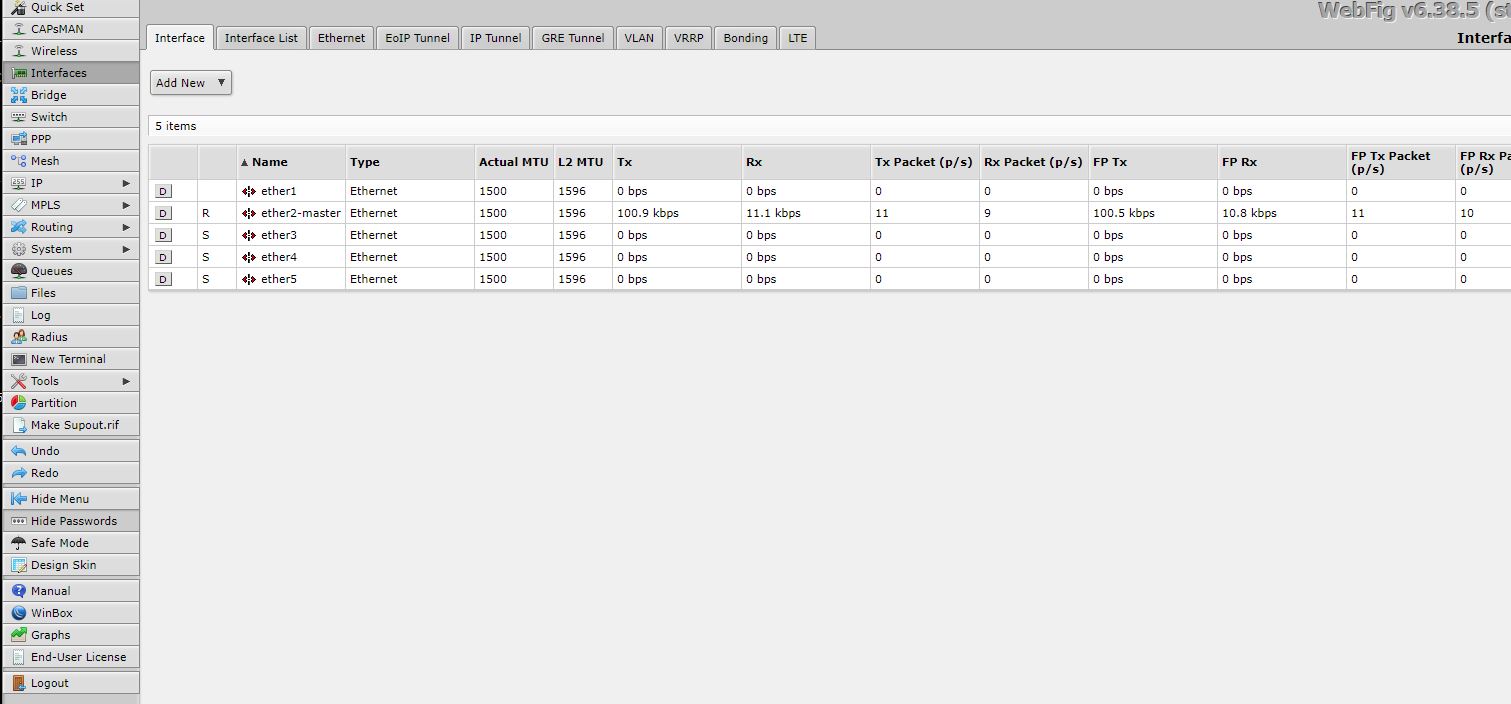
In either case, you can use GUIs like the WebFig or WinBox to manage your devices. If you are a novice but need to set up a VLAN, this is much easier than learning a new CLI to make a set-and-forget style configuration.
As with any device, ensure you change your passwords and put the management port onto a secure management network.
A Note on Performance
We typically use these for fairly simple networking either with flat networks or using some VLANs but without routing. Since our typical network usage is file transfers, we generally get line rate minus overheads when we pass traffic over 10GbE. If you need highly specialized networking or the lowest latency switch, you probably are not looking at the $130 price bracket. For its intended use, it is fine. Here are the official switching results from MikroTik:

Here are the Ethernet results:

As you can see, as you start to add features like IP filters and small packet sizes, the throughput drops to sub 1GbE speeds. If you are using it as a simple Layer 1/2 device for general home/ office usage, then you will get 10GbE speeds. Think of this as a simple Layer 1/2 switch.
Power Consumption
We tested power consumption on 120V power since that is common at the edge where these will be deployed in North America. In terms of actual power consumption we saw:
- Idle Power: 10W
- Max Observed Power: 13W
- Max Power from Spec Sheet: 18W
This is minimal overhead for using a switch instead of a direct-attach setup.
Final Words
This is a switch that we have in the lab that is not powered on 24×7, but we use it weekly. Its small size and deployment flexibility allow it to be used to add SFP+ network ports just about anywhere. At this price point, having a low-power, low-cost, and silent 10GbE switch, even if it is only four ports, is something that we recommend highly over stringing together direct connections. When one adds some of the company’s other low-cost products such as its 24x 1GbE switches that also have SFP+ networking, one can make an inexpensive and still reasonably fast network.
At this price range, it is an excellent switch for your desk. It is not the highest-performing switch out there with a low power CPU and 512MB of RAM. It has a WebGUI which increases a security attack surface but makes it more accessible. Our units have been reliable and there are features like redundant power, but it is not what we would want to see running the backbone of JPMorgan Chase’s banking network. Your office, home, a trade show demo, or a coffee shop, all are the target applications for the switch
At the same time, it is very easy to plug-in and start running for basic switching. So long as you are aware of the limitations, the MikroTik CRS305-1G-4S+IN is a great little switch. They are easy to find at your favorite MikroTik reseller or even on Amazon. Pricing is very reasonable and is almost always under the $149 list price.
We debated this within STH. This is a product that we have more than one editor that has purchased. We these switches used in trade show demos all the time by very knowledgeable people. While it is not perfect, for the price point, it is a stellar device. In the end, we decided to hand out our fourth ever STH Editor’s Choice award to the MikroTik CRS305-1G-4S+IN.

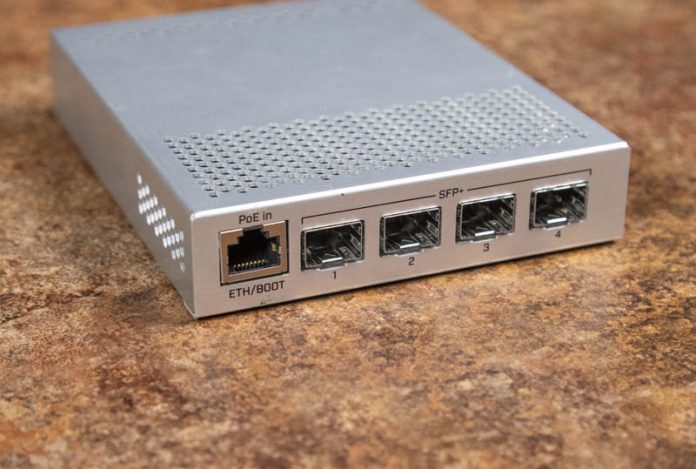
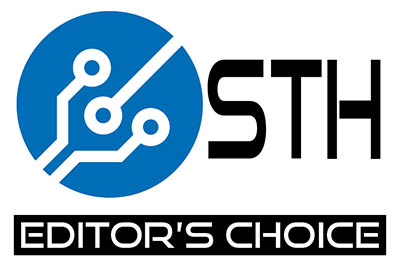



CRS305 is perfect for 2U4N proxmox clusters, with one RJ45 for the uplink.
I use this with 2 clusters already, and it is perfect. It certainly has it’s place!
This review is SPOT ON. I don’t think I’d trust these for super sensitive networks, but for a home, small office, lab or retail, sure. And they’re so cheap! And quiet!
Seriously, if you don’t have one (or more) just get one. You’ll also hate 10G base-T after this.
Why does that switch look a little banged up in front and on top?
Cool. I’ve been eyeing this for awhile. I don’t really have super big need for 10Gb at home except for maybe my veeam backup repository server to backup my ESXi servers nightly. My next purchase may be this and a few network cards, tranceivers and cables (kinda adds up to purchase all at once, but this is still the best price going now).
Thanks for the Review, any good experiences with low-cost 10Gb NICs to pair with this thing?
A couple of moments:
First – that heat problem is quite pronounced on the 4 port one and also on the 8 port one. A 12CM fan jerry-rigged to the top of that 4port switch with the slow-speed mod cable = no heat issues and not much sound. 8 port one needs a bit different setup for fan if you want one but some small breeze should be enough. I did not feel comfortable to run this thing as it is just because touching it could cause burns and that just did not make sense from safety perspective.
Second – have noticed that it has some problems in recovering the connection if the device on the other side does too frequent restarts. Specifically a mellanox CX3 with this – and it glitches, using it with Quanta monster ebay switch – had 0 problems, but with MT – a bit too much reboots and it feels like it flags that connection as dead and just does not try to recover it. Solution is to restart the affected server (if you can access it, he he) and that fixes it but from my testing – this does not happen on quanta lb6m. But it has happened a couple of times on MT. Two times with QNAP and CX3 sfp+ interface and a couple of times with windows computer that had CX3. If you have a backup 1G connection – and do not rely on this switch as the be all and end all problems sort of thing = then it is perfect! Just that there are some odd quirks here and there but for most of the time it does its job perfectly.
I haven’t seen any of that reboot issue. We’ve got one at every medical office we service and they’re solid. We just mount them high on the wall.
The 309 can be powered by PoE and DC jack for redundancy.
My FreeNAS based on supermicro C3758 has 10G-base-T port. What is the best way to connect it to this switch? Some 10GbaseT to SFP+ module? Or is it preferable to buy 10G SFP+ card for both the NAS and desktop?
Thanks
There are SFP+ to 10Gbase-T adapters, MikroTik makes a relatively inexpensive one.
Could you use this switch to hook up 2 10gb sfp and 2 1gb sfp at the same time ?
Looking for a cheap switch to connect my internet router to, it has only 1 10gb port and i need to have it connected to a firewall with an 10gb port and then 2 other devices that have 1gb connections that need to be before the firewall is this switch or the MikroTik CRS309-1G-8S+IN suitable for this type of application ?
Yes Paulo, that should work.
I like this little switch, I have one in my home lab. I’m booting to the SwOS since routing on this little device is not very practical. Perfect little backbone for my Proxmox, storage, and workstation.
Hi Rohit,
We are ISP in India. Trying to setup this switch.
We able to login via browser to switch and see details.
But when we connect sfp single mode modules we are not able to see any data transferring and also the link up is not showing. Is there anything we have to configure?
It will pass traffic when it is in the default configuration from MikroTik’s quick setup.
i would love to see the internals of this device.
Any idea if the CRS305 supports 2.5G HSGMII devices such as the Nokia G-010S-A?
I’ve found that most SFP+ switches/routers do not support 2.5G modules and can only run at 10G or 1G. A sub-$500 SFP+ device with 2.5G module compatibility would be a godsend!
I’m in the UK and I’d like to run this switch as a 2.5Gbps home router using the new S+RJ10 SFP+ module which supports 2.5Gbps speeds.
One of the SFP+ ports would be set as a WAN port and would connect to the 2.5Gb port on a new Virgin Media Hub 5 router (running in modem pass through mode and hosting Virgin Media’s new 2Gb Internet service). The other SFP+ ports would be configured as switched LAN ports running at 2.5Gbps (for a direct PC connection, a 2.5Gb wireless router connection, and a downstream 1Gb switch running all my other wired connections). Is this configuration possible with RouterOS.